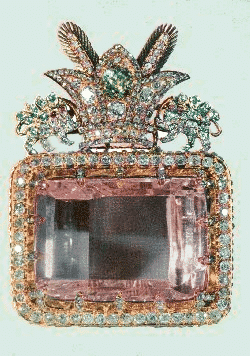
Darya-ye-Noor, translating “river of light” or “sea of light”, is the product of an undocumented – but what some might call happy- accident. The Darya-ye-Noor is believed to be a major portion of the fabled Great Table Diamond discovered in the Golconda mines of southern India.
The Great Table Diamond was one of the many stones shown to the famous jeweler and world traveler Jean-Baptiste Tavernier. In 1642 he documented his observations of this stone, writing that it was one of the “Largest and finest diamonds and rubies seen by him in Europe and Asia”. As noted by Tavernier, The Great Table Diamond’s weight was an impressive 242 carats. Unfortunately, by 1834 no one would ever share Tavernier’s experience with this Diamond again. Sometime during that year, it is believed that the Great Table Diamond was involved in some sort of unrecorded accident resulting in the creation (perhaps by necessity) of the 182 carat Darya-ye-Noor and its smaller sister stone, an approximately 60 carat diamond named Nul-ul-Ain. Because of its distinctive light pink color and flawless clarity most observers today feel that the Darya-ye-Noor’s ancestry is almost certainly linked to the Great Table Diamond.
As with many diamonds from this time period, the Darya-ye-Noor became part of the spoils of war. It is believed to have been brought to Persia (modern-day Iran) in 1739 as part of the loot captured in the campaign of Nadir Shah. Over time it passed through the hands of various relatives and associates of Nadir Shah until it ended up in the possession of Karim Khan, a Zand ruler of Persia.
The Darya-ye-Noor became a favorite decoration in the armbands of various Zand rulers and then Qajar kings. When this fashion for armbands went out of style the versatile gem was worn by Nasiruddin Shah on his chest as a brooch and on a hat. Eventually, the Darya-ye-Noor was mounted in a frame with crown, lion and sun motifs, enhanced by 475 smaller, various-colored diamonds and 4 rubies. This was incorporated into a royal aigrette and was worn on the caps of ruling monarchs until 1978.
The Darya-ye-Noor is still one of the world’s largest diamonds and remains part of the Iranian Crown Jewels currently residing in the Central Bank of Iran in Tehran, Iran.
Alternative spellings:
- Darya-yi Noor
- Darya-i Noor
- Darya-i Nur
- Darya-e Noor